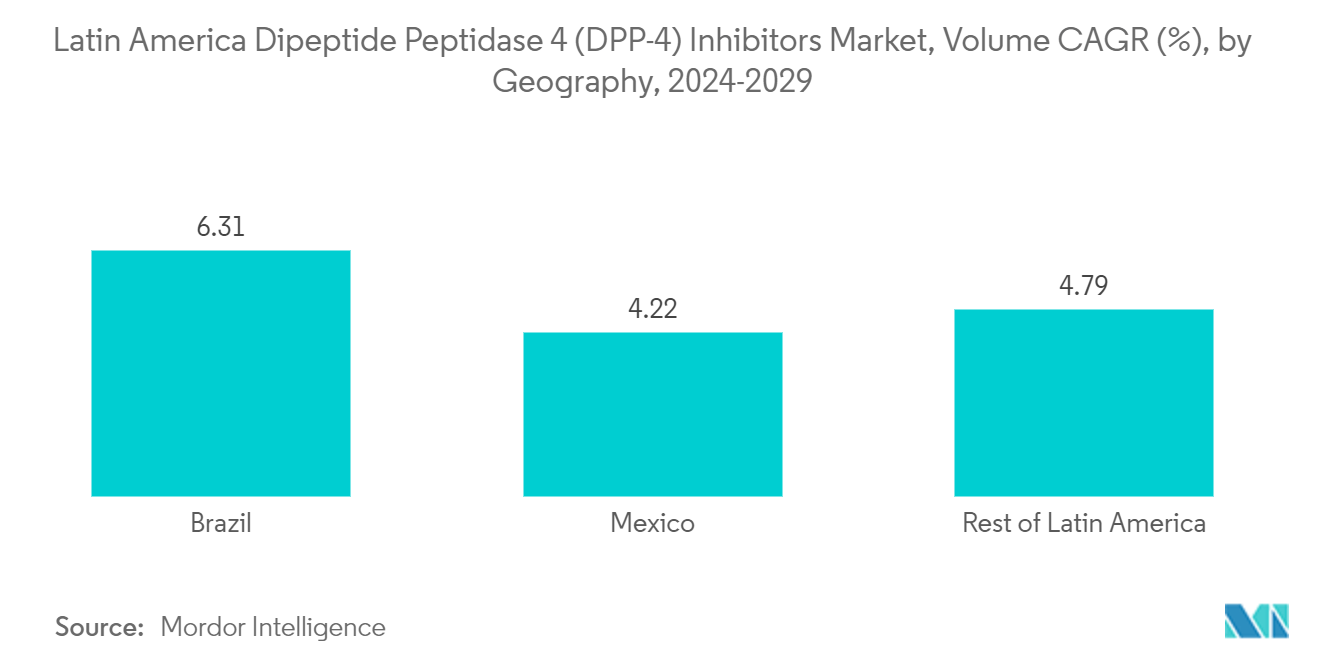Market Trends of Latin America Dipeptide Peptidase 4 (DPP-4) Inhibitors Industry
Tradjenta segment holds the highest market share in the Latin America Dipeptide Peptidase 4 (DPP-4) Inhibitors Market in the current year
The Tradjenta segment held the highest share in the Latin America dipeptide peptidase 4 (DPP-4) inhibitors market in the current year and is expected to register a CAGR of more than 7% over the forecast period.
The Food and Drug Administration has given the prescription drug Tradjenta the go-ahead to help adults with type-2 diabetes better control their blood glucose levels. It is also used as an add-on therapy to insulin. Tradjenta should not be used in patients with type-1 diabetes or for the treatment of diabetic ketoacidosis (increased ketones in the blood or urine).
According to the IDF Diabetes Atlas, the prevalence of diabetes in Mexico reached 16.9%, or one in six adults. Additionally, 11 million adults in the country have impaired glucose tolerance, which places them at high risk of developing type-2 diabetes. Diabetes-related health expenditure in Mexico has put it in the top ten countries or territories with the highest total health expenditure. Under half of the people living with diabetes in the country are undiagnosed.
Lack of health insurance deprives the poor of access to services and puts them at risk of financial hardship. To protect the people against excessive health expenditures, many countries like Mexico have implemented mechanisms such as community-based health insurance, national health insurance, and targeted public health insurance.
The rising prevalence and various initiatives by the Mexican government are expected to drive the market's growth.

Brazil is expected to dominate the Latin America Dipeptide Peptidase 4 (DPP-4) Inhibitors Market over the forecast period
Brazil holds the highest market share in the Latin America Dipeptide Peptidase 4 (DPP-4) Inhibitors Market and is also expected to register a CAGR of more than 4.7% over the forecast period.
According to the IDF Diabetes Atlas, 15.7 million adults, or 10.5%, were living with diabetes in Brazil. The cost of diabetes-related health expenditures in Brazil is the third highest in the world. In addition, 18 million adults have impaired glucose tolerance, which places them at high risk of developing type-2 diabetes. Additional data on glycaemic control in Brazil show that only 25% met the therapeutic goal of glycated hemoglobin (HbA1c) less than 7% before the pandemic, as recommended by the Brazilian Diabetes Society (SBD).
Urbanization, an aging population, declining levels of physical activity, and rising rates of overweight and obesity are just a few socioeconomic, demographic, environmental, and genetic factors that are contributing to the rise in type-2 diabetes cases in Brazil. When diabetes is undetected or inadequately treated, people with diabetes are at risk of serious and life-threatening complications, such as heart attack, stroke, kidney failure, blindness, and lower-limb amputation. These result in reduced quality of life and higher healthcare costs, which lead to a greater need for access to care.
The prevalence of diabetes is growing among all ages in Brazil. Diabetes mellitus has been of wide concern with its high prevalence, resulting in increased financial burdens for clinical systems, individuals, and governments. The government has partnered with numerous private companies to utilize their supply chains to ensure low prices for drugs. Brazil has implemented a set of reforms over the past decade to improve the distribution of doctors, develop new forms of service organization, introduce new financing models, and implement a range of quality improvement initiatives and policy frameworks to overcome risk factors such as obesity and emerging pandemic threats.
Owing to the factors mentioned above, the market is likely to grow over the forecast period.


